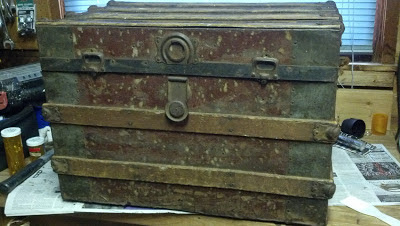First, there is a gap between two of the slats in the bottom and instead of fixing it snug, the maker just slapped a piece of cloth tape over it and then covered it with paper. I suppose they figured the metal covering would keep out the damp and whatnot, so I can't fault them, but I do think it's kinda funny.
Also, contrary to what I expected, most of the wood slats are very rough, not sanded smooth. Again, since the inside was covered in paper and the outside was covered in metal, why waste time sanding?
I'm very glad that my trunk doesn't smell of mothballs or anything else, really. When I steam away, all I smell is damp wood and old paper, and I don't mind that at all.
The wood is in pretty good shape, for being a century old.
Here's where the handle attached, where the worst of the rusted metal has to be taken off. You can easily see the original color of the paint, and the white and gold speckling that made up the "mottled" finish. I really wish there were a way for me to easily recreate that effect at home, but I'm not one for slinging around solvents and applying heat with torches. Things go boom!
I pulled the rusted-through metal off the right side. I thought it would be in one piece, but it wasn't; it was in strips about five inches wide, so I only had to remove one of the wooden slats to take off the bad pieces. The wood underneath seems fine. One or two of the nail holes are a bit worn, so I'll touch them up with wood filler before putting the new metal on.
The slat clamps (that's what those metal bumpy things on the corners are called) were pretty corroded by rust on this slat. I'll have to replace one for sure, maybe both, but i'm trying to retain as much of the old hardware as I can. (Oh, and those pieces of tape are marking where tackheads came off, leaving sharp little spikes in the wood that I'll have to dig out.)
I'm using a piece of aluminum to replace the stuff I took off. I've read sources that say the material on this trunk is tin, and others that say it's steel. I'm no metallurgist, but I do know that the steel and aluminum sheets I found at Home Depot were too thick, and they didn't have tin at all. One of our neighbors had a piece of aluminum vent that is just the right weight to match, and once it's painted I think it'll look fine. And if anyone wants to make a fuss about that, well, they can do the trunk rehab next time.
.jpg)














